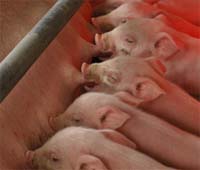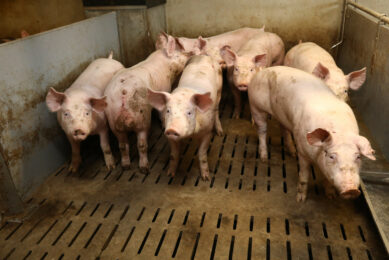RESEARCH: Factors uncovered to determine piglet weight at ten weeks

Piglet body weight at the end of the nursery phase is mainly determined by season, sex, birth and weaning weight and body weight at six weeks of age.
These results were pubished this month by a joint team of scientists from the Netherlands and France. The researchers, related to animal nutrition company Nutreco, several departments within Wageningen University (the Netherlands) and the French Pork and Pig Institute (IFIP – Institut du Porc), aimed to find out what influences piglet growth.
This is important to know in order to be better able to deal with within-batch variation in body weight gain during the nursery period (up to ten weeks). Homogeneity of body weight within batches of animals is important as it influences the efficiency of use of the grower and finisher facilities, and provides an extra value for the finishing farms.
France and the Netherlands
In the study, factors for a low body weight at the end of the nursery period of pigs were determined by analysing datasets from three different Swine Research Centres in the Netherlands and France. The entire dataset contained information on 77,868 individual piglets born in the period between 2005 and 2010.
Body weight was determined at different time points over the pre- and post-weaning phase, and sex, season of birth; litter information (litter size at day of birth and after cross-fostering, number of piglets born alive per litter, number of total born littermates, sow parity number); cross-fostered animals (yes or no), and pen group size over the post-weaning period were recorded.
A risk factor analysis approach was used to analyse the datasets to determine factors that predict piglet body weight at the end of the nursery period. Body weight at the end of the nursery period corrected for age was mainly determined by season, sex, birth weight, weaning weight and body weight at six weeks of age.
These variables were consistent among datasets and explained approximately 70% of the overall variation in body weight at the end of the nursery period. Litter information did not significantly contribute to explaining the body weight at the end of the nursery period.
To discard the possibility of intra-uterine growth retarded piglets (IUGR) being the reason for the influence of birth weight as an explanatory factor in the regression model, a further analysis was performed on the effect of this category of piglets on the results of the regression analysis.
Conclusions
Overall, it was concluded that piglet body weight at the end of the nursery phase is mainly determined by season, sex, birth and weaning weight and body weight at six weeks of age.
Piglets with a birth weight higher than the mean birthweight minus 2.5 times the standard deviation have the potential to compensate during the subsequent phases of growth.
The research is published in this month’s edition of the Journal of Animal Science.
Related websites:
• French Pig and Pork Institute (IFIP)
• Nutreco
• Wageningen University
• Journal of Animal Science











